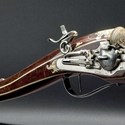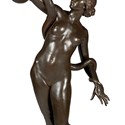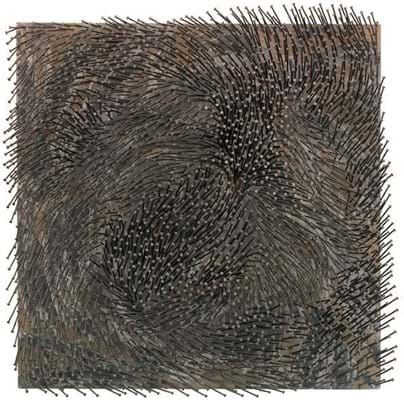Bidders with an eye for the unusual were particularly taken by an early 17th century hand mortar or grenade gun offered in Munich.
It was one of the highlights at the May 1-10 sale series of historical memorabilia and weapons at Hermann Historica (25% buyer’s premium).
Very few such pieces have survived, which should not come as a big surprise when the gun’s modus operandi is taken into account.
It is basically a large-bore flintlock musket which was primed with gunpowder. An explosive grenade was prepared, its fuse lit and it was then placed – carefully – into the barrel and fired in the direction of the enemy. It is thought that many operators lost their lives when the grenade exploded prematurely.
The earliest examples of this type of weapon date to the 1580s. The one in Munich, measuring 2ft 1in (63cm) long, was thought to be c.1610-20.
It was very finely decorated, which suggests that it might have been made as a ceremonial piece. The bronze mortar barrel is engraved with trophies and blossoms, the walnut stock is inlaid with engraved and blackened bone, while the butt is modelled as a dragon’s head, with eyes and teeth fashioned from bone.
A very similar piece, most certainly from the same south German workshop, belongs to the Musée de l’Armée in Paris.
The moderate starting price of €18,000 attracted a barrage of bids which came to an end only at €120,000 (£106,195).
Porcelain and sculpture
On May 19, also in Munich, Neumeister (27% buyer’s premium) auctioned porcelain and other works of art from the collection of the art historian and ceramics expert Alfred Ziffer, who died in 2017.
His specialist field was the Nymphenburg factory on the outskirts of Munich. One particular figure modelled by Franz Anton Bustelli (1723-63) caused the biggest stir. It was a 6½in (16cm) figure of a lady-in-waiting, holding her lady’s dog in one hand and a muff in the other.
Bustelli is considered by many to be one of the finest creators of Rococo porcelain, equalled only by Johann Joachim Kändler, who worked at Meissen. Little is known about his early life but from November 1754 until his death he was responsible for many of the most iconic figures in Nymphenburg.
He is renowned for his 16 figures from the Commedia dell’arte, but also for courtly figures such as this lady-in-waiting sold in Munich. It was modelled in 1755, making it one of Bustelli’s earliest creations for the factory, and was once part of the Christner collection, which was sold at Christie’s in New York in 1979.
At €2000-2400 the estimate was very enticing and furious bidding ensued between numerous dealers and collectors. The anonymous buyer had to bid €60,000 (£53,100) to seal the deal.
Several weeks later, on June 8, Neumeister had a very different type of female figure to sell, which turned out to be the top lot of the auction. It was Schlangenbänderin (Snake charmer), a 4ft 8in (1.45m) high bronze of a nude woman with a snake, a classic example of fin-de-siècle sculpture. The bronze was modelled by Fritz Klimsch (1870-1960) in 1898 and cast in the H Noack foundry in Berlin-Wilmersdorf.
This figure was made in two different versions. One, with a single-headed snake, was published in Volume 20 of The Studio in 1900 and is identical to the figure that was exhibited at the Grosse Berliner Kunstausstellung (Great Berlin Art Exhibition) two years previously. The other had a three-headed snake and was the model offered in Munich.
Although he had only finished his studies at the Berlin academy in 1894, Klimsch had already made a name for himself with his portraits, memorials and mythological motifs, many of which were influenced by Rodin. The catalogue guide was €60,000-100,000 and in next to no time the bidding reached the top estimate (£88,495) and the figure was sold to an unnamed buyer.
Modern and contemporary art
Piero Manzoni (1933-63) led the field by a long way at the June 6 sale at Lempertz (24% buyer’s premium) in Cologne. In his short life the artist created a multi-faceted, often highly provocative oeuvre, challenging many accepted artistic beliefs.
An example was the Achrome from 1958 which Lempertz offered with a guide of €400,000-500,000, a 16 x 20in (40 x 50cm) “unpainterly” painting as the artist described it.
The work was composed of canvas soaked in kaolin and folded to create a remarkably subtle effect of plasticity. It was consigned by a local collector and caught the eye of several bidders who pushed the price up to €690,000 (£610,620).
Two highly different works took top honours at the sale of contemporary art at Ketterer (25% buyer’s premium) in Munich on June 9.
At the top of the list was a characteristic nail painting by Guenter Uecker (b.1930), one of the few surviving members of the Zero group of artists.
His 4ft 1in x 3ft 11in (1.25 x 1.2m) composition Woge, Japan (Wave, Japan), made of wood, canvas, nails and paint, was executed in 1995.
On the rear of the canvas is not only the date, the title and the artist’s signature, but as usual also an arrow, to assist the owner when hanging the picture.
The painting had been owned by a north German collector since it was created and was estimated at €600,000. A Bavarian collector saw off his German and Swiss competitors with his final bid of €660,000 (£584,070).
Another Uecker, the 16 x 12in (40 x 30cm) nail painting Feld (For Ezra Pound)/Field (For Ezra Pound) from 1999, went over the estimate to sell to a British collector for €160,000 (£141,590).
Standing 8ft 3in (2.52m) tall, Tony Cragg’s bronze Point of View, one of an edition of three, cast in the foundry Kayser in Dusseldorf in 2002, requires a lot more space than an Uecker painting.
A German collector bought it from the artist and now, 16 years later, it was offered by Ketterer for an expected value of €300,000.
Several German collectors joined in the bidding and eventually the hammer fell at €530,000 (£469,025). Once again a Bavarian collector was the successful bidder.
This is the highest auction price for the artist, going over the level set by Sotheby’s in London in July 2015, when his bronze Wt (Two Columns) from 2011 was knocked down for £360,000, which in those days was almost €508,000.
£1 = €1.13


























